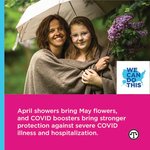

By We Can Do This COVID-19
Public Education Campaign
(NAPSI)—After a few weeks without rain, most people don’t throw out their umbrella. Just because someone has driven thousands of accident-free miles, that doesn’t mean seatbelts should be abandoned. Similarly, health officials encourage people to think about such prevention measures as wearing masks in the same way that we think about our umbrellas. People shouldn’t stop taking steps to protect themselves and others from COVID-19, even if there is a lull in cases.
“COVID changes over time, and what we know about the virus causing it has expanded, providing effective tools for preventing severe illness, hospitalizations, and deaths,” said Dr. David Banach, associate professor of medicine at UConn School of Medicine and hospital epidemiologist at UConn Health/John Dempsey Hospital. “It is vital that we continue to layer prevention strategies based on local COVID transmission rates coupled with individualized measures for high-risk populations to reduce the impact of the virus on individuals and the larger community.”
The most effective ways to prevent COVID are simple and widely available to all Americans.
Stay up to date on vaccines. Vaccines and boosters protect people from the worst outcomes of COVID and help reduce the spread of the virus in communities, further reducing risks for the most vulnerable populations. Boosters provide extra protection. Like seatbelts prevent injuries in accidents, vaccines are highly effective at preventing hospitalization and death from COVID, but they don’t work if you don’t use them. Vaccination is the best way to slow the spread of COVID and prevent hospitalizations and deaths. COVID vaccines are available to anyone age 5 and older in the United States.
Wear a mask. After vaccines, wearing a mask is one of the most effective ways to help reduce the spread of COVID. The Centers for Disease Control and Prevention (CDC) recommends wearing a mask in public indoor spaces, especially in areas where community transmission is high. A mask should fit closely on the face, covering the nose and mouth, without any gaps along the edges or around the nose. Masks are still required on most methods of public transportation.
Keep your distance. If you are not up to date on COVID vaccines, stay at least six feet away from other people, especially if you are at higher risk of getting very sick with COVID. In areas where community levels are high, it is best to avoid crowded places where it is difficult to stay distanced from others who may not be vaccinated. When spending time with people who don’t live with you, outdoors is the safer choice. Holding gatherings outdoors decreases the chance of COVID exposure.
Layering these proven prevention strategies in line with your personal health risk and current community levels of COVID transmission, is the best way to prevent severe illness, hospitalization, and death. Don’t throw away that umbrella, keep wearing a seatbelt, and stay current on COVID vaccines even when cases are lower in your community.
For accurate, science-based information about vaccines, visit www.vaccines.gov.